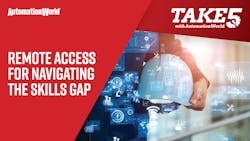
Quick hits:
- Deloitte predicts 2.4 million manufacturing positions will go unfilled in the next decade.
- New workers will be required to possess a new set of information technology (IT) skillsets, which were previously less common in manufacturing.
- As older workers retire, knowledge pertaining to legacy system will need to be preserved as well.
- While only a short-term solution, remote access coupled with augmented reality could help to buy manufacturers time.
- Remote Access and the Skills Gap Connection
- Siemens and Dow Unveil Process Industry Testbed at MxD
- How Artificial Intelligence is Being Used to Streamline Training
- Visit PMMI's Business Intelligence Library and download their executive summaries of their latest reports for free
Hello and welcome to Take Five with Automation World. I’m David Miller, Senior Technical Writer for Automation World. Today, I want to talk about a specific aspect of the skills gap, and how remote access and augmented reality technologies can help companies to navigate it.
Now, as many of our viewers most certainly know, there is a mounting issue with a lack of skilled talent in the manufacturing industries – A common statistic that’s bandied about all the time it from Deloitte – 2.4 million manufacturing positions are projected to go unfilled in the next decade. And this is particularly frightening as many companies attempt to reshore their operations to strengthen the domestic supply chain.
But often when we talk about this skills gap what comes to our mind is many of the new skillsets workers will need to enter into a more digital, advanced manufacturing landscape – That is, rather than merely being operational technicians who work on machinery, we expect them to have more IT skills – more data literacy – familiarity with databases -- coding and programming knowledge – and so forth. And that’s certainly a challenge. But there’s also another side to that coin that’s less frequently addressed: Namely, that the new workers coming in need to know not only how to operate new technologies, but how to maintain legacy systems and older equipment as well. And that’s because most manufacturing operations are engaging in incremental automation, rather than a wholesale rip and replace of their assets. So, what you have are facilities that are usually making use of a complex mixture of old and new technologies.
And this presents a challenge. Because many older workers are nearing retirement age, and they may be the only ones who know how to operate and maintain that legacy equipment. So the question then becomes, not only “how can we get new workers familiar with new technology?” but also “How can we make sure they’re also familiar with older technology?”
So, how can remote access and augmented reality technologies help solve this problem? Really, there are three different ways. First of all, augmented reality headsets that can be worn by workers in the field can provide them with real-time work instructions that can greatly accelerate the learning process when it comes to operating on technology they are unfamiliar with. These devices have access to digital databases of schematics and other training materials, which can be superimposed directly over their field of vision.
But where it really gets more interesting is the second thing. These devices can be used for knowledge capture before older workers leave an organization. That is, they can film themselves doing tasks, and talking through them very easily and those videos can be stored and made accessible to new workers – a kind of audio-visual instructional file. It seems simple, but if you think about, it’s really only recently that we’ve been able to have the kinds of recording technologies that achieve this affordably in the hands of every worker. Not only that, but aggregating and disseminating the information back to workers may require a large cloud database.
And the final thing follows from that – Not only can pre-recorded training materials be delivered to AR headsets, but live remote assists can as well. When COVID first got started, we saw a huge explosion of remote access technologies, largely out of necessity, but now that the infrastructure is in place, they can be used for all kinds of other things. And something we’ve seen is that retired workers are being called in to give real-time remote assists for difficult tasks on legacy systems they may have spent decades getting familiar with. It’s not uncommon for former engineers to come out of retirement for brief periods of time to work on specific projects, but this allows for even more flexibility than that. A retiree could literally be laying on a beach in Hawaii, while offering one of these remote assists. They don’t even need to travel to a physical location to do it anymore. And so it becomes a kind of very flexible contract consulting, which can go a long way to bridging that skills gap.
In any case, that’s all I have for you today. If you enjoyed this video, stay tuned for more to common in the days ahead.
